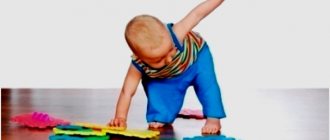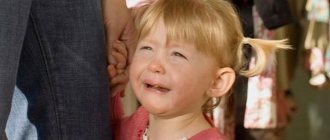June 07, 2018
Averyanova Sveta
Left-handed children have an excellent ear for music, show unique abilities to solve non-standard problems, and are drawn to various types of fine arts, but the development of speech is sometimes delayed. Parents are worried whether it is dangerous to be left-handed in the modern world, and whether this will affect learning in kindergarten and school.
Even in this progressive age, writing with the left hand still evokes an emotional response in society. What should parents do with an unusual child? Do they need to retrain a left-handed person and what should not be done with him? Science has long found answers to these questions.
Reasons for the birth of left-handers
From 7 to 17% of the population are left-handed. This means that approximately every seventh baby is born right-brained. And there is no pathology or deviation from the norm in this. From a biological point of view, left-handers are genetically healthy people.
This is interesting ! The phenomenon also occurs in other species. Left-handed dogs, for example, are more likely to learn circus tricks and search work than a general training course.
The brain is responsible for laterality. The cerebral hemispheres control the body crosswise: the right hemisphere is responsible for the functions of the left half of the body . Hence the synonym – right hemisphere.
This hemisphere of the brain is responsible for creativity, imagery and spontaneity. While the left hemisphere, which predominates in most people, gives them logic, consistency and analytical abilities.
What determines the appearance of left-handed babies has not yet been determined exactly. Among the confirmed factors of left-handedness, three can be distinguished:
- Before birth : genetic factor.
The right hemisphere is inherent in the DNA, and already at the moment of conception the unborn child is left-handed. - At birth : traumatic factor. Compensation for the consequences of left-hemisphere birth injuries leads to the active development of the right side.
- After birth : environmental factor. There may be imitation, forcedness, overtraining, injuries to the right hand.
Features of left-handed children
As studies by neuropsychologists show, true left-handers have a more perfect brain organization than right-handers. They have a well-developed corpus callosum - a special zone that is responsible for the interaction of the cerebral hemispheres. They also have symmetrically located speech zones, whereas in right-handed people they are mainly localized in the left hemisphere. Thanks to all this, true left-handers process information faster, adapt more easily to a right-handed world, and are often talented in a variety of areas.
It’s another matter when left-handedness is a consequence of a birth injury. In this situation, the right hand turns out to be weaker than the left and obeys worse, so the child has to use the genetically non-dominant left hand. Unlike true left-handers, compensatory children have a more difficult time learning: delayed speech and mental development are common accompanying diagnoses for such children. In compensatory left-handers, the brain literally works “to wear out”; they need neuropsychological help. What’s interesting is that, in contrast to true left-handers, who cannot be retrained under any circumstances, compensatory left-handers, as a result of specialized training, may well change their leading hand and “refocus” on the right hand.
Left-handedness and left-handedness
True left-handedness is the result of a genetic factor. The right hemisphere of the brain in true left-handers is more active by nature and predominates in everything: in everyday life, learning, sports, communication. Not only the arm, but the entire left half of the body is used more intensely.
Left-handedness as a result of injury is forced. A negative impact on the left hemisphere of the brain leads to activation of the right, and the growing person masters the world differently than most of his peers. In real and compensated left-handers, creative activity predominates, imagination and intuition are developed.
Left -handedness is a habit, a preference for the left hand for writing, playing and holding cutlery. In all other respects, a left-handed person is no different from a right-handed person, including genetically.
This is interesting ! Preferring the right or left hand for writing is not an absolute sign. A right-hemisphere person can write with his right hand, but for other types of activities he chooses his left.
Left-handed or right-handed?
If a child actively uses his left hand, for example holding a spoon in it, you should not immediately say that he is left-handed. In children, left-handedness is often a temporary phenomenon and only indicates that the development of interhemispheric interaction is not complete and the dominance of the left hemisphere, and accordingly, the right hand in providing motor functions (while eating, when writing or drawing, etc.) is not secured . In this case, with a gradual increase in the functional resource of the left hemisphere, a “miraculous transformation” of a left-handed person into a right-handed person often occurs. It is possible to say one hundred percent that a child is left-handed only after 5 years of age - by this time the right hemisphere has matured.
True left-handers - those who rule the show not only with their left hand, but also with their left eye and left ear - will be brought to light by a simple test: ask your child to take the alarm clock with both hands and listen to the ticking of the clock. The ear to which the child puts the alarm clock will be the “leading” one. To calculate the “leading” eye, roll a piece of paper into a tube and ask the child to look through the “spyglass” at the objects around him. If a child brings it to his left eye, he is definitely a little left-hander.
How to determine whether a child is left-handed or right-handed
The choice of laterality occurs most often at the age of about 3 years, less often - closer to 6 years. And a fifth of people grow up without having decided on their dominant hand, having equal control of both limbs.
This phenomenon is called ambidexterity.
Once the baby begins to actively use his hands to grasp and hold, parents can develop the necessary skills for living in a right-handed world.
But how can you determine which hand is the baby’s dominant? The first and most accessible diagnostic tool is observation. Parents need to take a closer look at their child and note with which hand he manipulates objects:
- moves a movable toy;
- folds a pyramid;
- indicates something;
- collects small objects (pebbles, buttons);
- holds cutlery;
- brushing his teeth;
- unscrews the caps;
- sweeps or wipes surfaces;
- combs;
- draws and writes.
Also note which hand becomes the supporting hand when falling, which side the thumb is on top when gripping the handles into the lock.
For reference ! Dr. Komarovsky advises testing left-handedness based on signs of left-footedness, vision and hearing functions. Functional tests help identify a hidden left-hander.
The intellectual and sensory abilities of true left-handers are absolutely consistent with the norms, but the manifestation of some developmental features is possible:
- Perseverance is developed with difficulty ; each structured lesson is given to the child with effort.
- Speech is formed somewhat more slowly and more intermittently: from a “sleeping” state it suddenly makes a leap.
- Sound pronunciation is far from ideal , but consultation with a speech therapist can easily solve this problem.
- Mathematical abilities : geometry and stereometry are easier for such children.
The methods for solving problems are extraordinary. - Good hearing, close to absolute . The child prefers the structure and sound of the classics.
- may arise with orientation in space ; it is difficult for the child to master the directions “right - left”, “top - bottom”.
- Artistic taste , a sense of color, balance, harmony develop earlier and appear brighter.
- Emotionality is higher and develops more actively.
It is important that parents’ observations and concerns are accompanied by competent diagnosis. Regardless of the dominant hemisphere, children may suffer from actual brain dysfunction. For example, some symptoms are considered not only as signs of right hemisphere, but also as alarm bells:
- mobility that is not amenable to pedagogical correction;
- pronounced disorders of the emotional-volitional sphere;
- stable mirror reproduction of a picture or text;
- significant delay in the development of speech and mental functions;
- various forms of dyslexia in children over 4 years old.
A left-handed child needs patient support from adults. He needs to be helped to get used to the space. Parents need to control themselves and not break down with phrases: “Are you completely stupid?”, “You don’t know right from left?” What is obvious for right-handed children is difficult for left-handed children.
Most people on our planet are right-handed. However, as a result of the development of the brain, the leading hand may become not the right, but the left hand, which is also considered a variant of the norm. This is due to different activity of the cerebral hemispheres. A left-handed person leads with his left hand. This indicates the dominance of the right hemisphere, which is called the emotional one. It is responsible for creative thinking, instant perception of an image, intuition, and imagination. From childhood, such people grow up more emotional and artistically gifted. They draw and sculpt from plasticine better than their peers, and have musical abilities. At the same time, they are characterized by speech delay and difficulty in pronouncing various sounds. The characterization of a left-hander involves highlighting such qualities as spontaneity, gullibility, and sensuality. In these children, mood changes occur instantly, resulting in tearfulness, whims, manifestations of rage and anger, and persistence.
The dominance of one of the cerebral hemispheres, and therefore the formation of the leading side of the body in a child, usually occurs by the age of five. Until this moment, children can pick up a spoon, pencil or scissors with both their right and left hands. At this time, it is important not to insist on choosing one hand or another. Then dominance will be established naturally.
Causes of left-handedness
What contributes to the fact that the child’s left hand becomes the dominant hand, and not the right? There are three main causes of left-handedness in children:
- Genetic predisposition. Heredity is the main cause of left-handedness. It is safe to say that in families where at least one of the two parents is left-handed, left-handed children are most often born. At the same time, in other respects they develop on a par with their peers and differ from them only in this feature.
- Left hemisphere damage. As noted above, the right hemisphere is responsible for left-handedness, and vice versa. Thus, as a result of malfunctions in certain areas of the brain in the left hemisphere, the child compensates for one hand with the other. First, he begins to use his left hand when performing household manipulations, and then when writing and drawing. At the same time, such children often experience speech and motor delays, which is associated with damage to the left hemisphere.
- Forced left-handedness. In this case, the child becomes left-handed due to injury or by imitating other children.
In addition, there is a separate category of people who can use both their right and left hands equally well. If a “problem” can be detected in such a left-handed person at an early age, then he can easily be made right-handed. In this case, the cause of left-handedness is the lack of interhemispheric interaction, which is one of the features of brain development.
Psychological characteristics
It is not at all easy for a left-handed child to adapt to a world where everything is designed for right-handers. As a rule, the first problems await children and their parents already at school. Many things are more difficult for them than for their right-handed peers. This is directly related to the psychological characteristics of left-handers:
- Phonemic hearing. The ability to distinguish different sounds in left-handed children develops more slowly than in their right-handed peers. They usually start speaking later, but often in complex and long sentences.
- Perception of space. Left-handed people are quite poorly oriented in space, they have poorly developed visual memory and motor coordination. Often such children cannot remember for a long time which hand is their left and which is their right.
- Orientation in time. It should not be surprising that a left-handed child cannot determine the time on a clock with hands. He can perceive them in mirror image for a long time.
- Control over mental activity. Left-handed children can easily invent new ways to master the world of right-handers. It is much more difficult for them to build verbal sequences and images in the traditional right-handed way. That is why they achieve the desired results in a roundabout way.
A left-handed child easily falls under the influence of his immediate feelings and moods. He has predominant temperamental traits such as anger, timidity, conscientiousness, and an increased level of anxiety. But at the same time, they are able to earn more than their right-handed colleagues. Among them are many artists, musicians, actors, athletes and artists.
What makes lefties unique?
The fact that left-handed people are different from right-handed people is a fact which, by the way, has given rise to many opinions about their genius and exclusivity. And every left-hander really has certain inclinations. The task of parents is to accept the characteristics of left-handers, identify their abilities in time and try to develop them. Then the child will be able to achieve high results in everything in the future.
Among left-handers there are many gifted and truly brilliant people. The most famous personalities are Alexander the Great, Napoleon, Charlie Chaplin, Aristotle, Pablo Picasso, Leonardo da Vinci, Julia Roberts, Nicole Kidman, Angelina Jolie and many others.
Learning abilities
When raising a left-handed person, you should always remember about his increased emotionality and vulnerability. The same attitude towards the child is required in the process of his education. Left-handed children need approval and praise even more than right-handed children. A positive assessment of his actions from the outside is important to him. Therefore, during the learning process, both at home and later at school, parents should not skimp on praise for successfully completed work. It is important to be able to develop optimism and an active attitude towards life in a child.
Due to their increased emotionality, left-handed children become overtired very quickly. Therefore, in the process of training them, it is important to follow the following recommendations of psychologists:
- maintaining a daily routine;
- mandatory sleep and rest during the daytime;
- short duration of classes (no more than 15-20 minutes for a child aged 3-5 years).
By adhering to the recommendations presented above, you can avoid excessive fatigue of the child and exhaustion of his nervous system.
Left-handed people have a more difficult time developing familiar skills. It is difficult to teach them to do everything according to the generally accepted pattern, for example, brushing their teeth in the morning, making the bed, changing into home clothes after going out, putting their things in their place, etc. Such children do not remember well the order of actions, the correct spelling of letters. If you want to teach your child to draw or write beautifully on their own, be sure to purchase a stencil or special copybooks for children. Only in this case will the baby produce neat images or letters. Today you can even buy a guitar for left-handers in specialized stores. It will be much easier for your child to learn to play such an instrument.
Possible problems at school
Psychologists believe that children with a dominant left hand have some difficulties in school. At the very least, during the learning process, left-handers should pay more attention to reading, writing and arithmetic compared to right-handers. These children have certain impairments in visual perception and memory. In turn, this leads to the following problems for left-handed children at school:
- writing letters in mirror image;
- slow pace of writing;
- unstable handwriting;
- confusion in geometric shapes that are similar in shape;
- confusion in letters and numbers with similar geometric elements in writing.
Most parents of children whose left hand is dominant are familiar with the phenomenon of mirror movements. For some, it is expressed in the form of a mirror letter (the child begins to write the word from the end, that is, from the letter with which it ends). Other children draw, read, and perceive any other information in mirror images. At school, copybooks for children with a dominant left hand will help solve this problem.
As a rule, mirror perception occurs in children under 10 years of age. If it continues, the child may need special classes. They will help correct deficiencies in spatial perception, coordination and attention.
The problems of left-handers in school are often associated with their slow perception of information. Such a child will need much more time to write the same passage of text than a right-handed child. It turns out that a left-handed student puts more effort into penmanship, but his results are often worse. For most left-handed people, their handwriting does not straighten out and remains that way for the rest of their lives.
Just a test for left-handedness
Based on the test results, you can find out about the activity of the child’s brain hemispheres, which are responsible for which hand will be dominant - right or left.
By the way, it is recommended to complete the tasks after the child turns five years old. Until this time, the child’s right or left hand can alternately lead.
The test tasks look like this:
- Interlace your fingers into a lock. If the thumb of your left hand is on top, write down the letter L on paper, and if the thumb of your right hand is on top, write down the letter P.
- Imagine a target in front of you and aim at it. If you close your left eye to do this, leaving your right eye open, write down the letter P on the paper. Otherwise, write down the letter L on the sheet of paper.
- Cross your arms over your chest. If your left hand is on top, write L, and vice versa.
- Applaud. In this case, left-handed children usually hit their right palm with their left palm, while right-handed children perform similar actions in reverse. In the first case, the letter L should be written on the sheet, and in the second, the letter P.
Notes on a piece of paper made during the test will allow you to evaluate whether the child is left-handed or right-handed:
- PPPP - the child is 100% right-handed;
- LLLL is 100% left handed.
Further, the percentage of dominance of the right or left hemisphere depends on which letters according to the test results are greater. Right-handed people have excellent abilities in languages, reading and writing. Left-handers are more creative and emotional people. They know how to dream and fantasize better than others, and have good abilities in music and the visual arts. Absolutely anyone can determine the dominance of the hemispheres of their brain, regardless of whether they write with their right hand or their left.
Do I need to retrain a left-handed person?
Just 20 years ago, a child with a dominant left hand was a rare guest at school. The fact is that already in the first grade he was necessarily retrained from left-handed to right-handed. Today things are completely different. Psychologists recommend that when working with a left-handed child, avoid retraining. Otherwise, there will be gross and completely unnecessary interference in the special mechanisms of brain activity. No one can predict or control what the consequences of these actions will be.
Retrained left-handers often experience the following neurotic symptoms:
- loss of appetite;
- insomnia;
- headache;
- fears;
- enuresis;
- stomach ache;
- stuttering;
- increased excitability;
- irritability;
- restlessness;
- lethargy;
- obsessive movements.
It should be noted that if, for a number of reasons, the leading hand is abandoned, then it must be accompanied by the involvement of the second side. In this case, playing with a ball, swimming, modeling, embroidery, knitting, aimed at developing coordination of finger movements, can be useful. It is recommended to conduct such exercises daily for 15-20 minutes.
Statistical data also shows the dangers of retraining. According to them, every third student with a stutter is a left-hander who was retrained at one time. Left-handed children often suffer from neuroses. This issue is being deeply studied to this day.
A left-handed person feels quite comfortable in a world where neither parents, nor teachers, nor peers support him and do not judge him. Such a child may well become a full-fledged member of society. In special stores today you can purchase everything necessary for the development and education of such children, from stationery to a guitar for left-handed people. This will help the child take his rightful place in right-handed society.
Note to parents
Psychologists confirm that it is impossible to change what is inherent in nature. This is wrong and unnatural. The consequences for the child in this case can be disastrous. This means that parents are faced with the task of helping their boy or girl adapt more quickly and easily to the conditions of the surrounding world. To make this process easier, parents can do the following for left-handed children:
- organize the workplace so that the light source is on the right side;
- do not focus the child’s attention on tilting the letters to the right when writing;
- perform exercises with children aimed at developing motor skills and visual perception;
- have a positive attitude towards the developmental characteristics of your child.
All lessons with a left-handed student should be carried out systematically and take no more than 20 minutes. Then he needs to be given time to rest, after which he can continue his educational activities. The characterization of a left-hander gives an idea of him as a vulnerable, emotional and creatively gifted child. The task of parents is to accept him for who he really is and develop in him all those qualities that are inherent in nature.
Do I need to retrain
People around you always touch the main parental nerve: you must teach your child to write with his right hand at all costs! Whether a child will be comfortable living in a right-handed world depends on how the parents react to their child’s normal features.
There is nothing wrong with holding cutlery or writing utensils in your other hand.
If a child grows up with the confidence that he is the same as everyone else , he will not have difficulties in sports, everyday life, or driving a car. He will not experience discomfort from eating or writing with his left hand.
Important ! The modern view of left-handedness is this: if you start retraining a true left-hander, this will upset the child’s psychological balance.
The pressure of right-handed rules requires the child to have greater mental strength, which he could spend more effectively on adapting to the world around him.
It is important to consistently build self-confidence in a child. He should not be ashamed of his uniqueness. Help him understand the possibilities and fully adjust to life. Soon he will see that he is more successful at what others struggle with.
In most cases, nature is wiser, and retraining a left-handed person is at least incorrect:
- The body of a genetic left-hander is initially designed to work in a mirror way . Retraining will lead to the appearance of neuroses and obsessive states in a child who already lives according to unusual rules.
- Retraining compensatory left-handedness is an intrusion into the natural process of rehabilitation and adaptation of the psyche and physiology of a little person who was born genetically right-handed. He is forced to make efforts to achieve comfort after injury. Why go against this?
Restoring the functions of the left side of the brain in case of injury does not require shifting the pencil to the other hand, but a whole range of measures.
If a genetically right-handed child strives to operate with his left hand and is successful in this, let him act. Such training helps to open up unprecedented brain capabilities. Left-hemisphere children who use their left hand are more successful in sports and school, their mental and physical abilities are universal.
The consequences of retraining a left-hander can be:
- enuresis of a neurotic nature;
- movement disorders;
- sleep disorders;
- fatigue;
- tics;
- disturbances of appetite and digestion;
- stuttering;
- low adaptation;
- attention and memory disorders;
- decreased will;
- weight fluctuations;
- dizziness and pain;
- emotional disturbances.
This is only part of the possible consequences of parents and teachers trying to fit a left-handed child to generally accepted standards. But, as it turns out, this cannot be done, since an overeducated child is more susceptible to the development of various pathologies.
Watch the story, which tells in detail and interestingly about the developmental features of a left-handed child.
If the child is left-handed
Most of humanity is right-handed and only 5-12% of all are left-handed . Foreign scientists note that from year to year the number of left-handed people is increasing: in 1928, among adults, 3.3% of left-handed women and 4.7% of left-handed men were identified. In 1973, the number of left-handed women increased to 8.8% and men to 10.4%, and in 1979-88 it reached 12.4% among women and 13.9% among men. Of course, left-handed people are in the minority and become even smaller as they grow older. The experience of many countries in the world, in which left-handed children are not only not re-educated, but also created all the conditions for a normal existence, education, and obtaining a profession, has convincingly shown that caring for these children has a beneficial effect on their development.
Negative attitudes towards left-handedness have a long and long history. As a rule, in various cultures, positive qualities were correlated with the right, negative - with the left. The antiquity of this prejudice is confirmed by linguistic analysis. In many languages, “left” is not only a synonym for “awkward”, “clumsy”, but also “unclean”, “insincere”, “sinister”.
“I understand everything,” complains the mother of a left-handed son, “but I can’t help myself, I perceive left-handedness as a disadvantage, even, I admit, as a defect.” “No matter what you say,” the primary school teacher continues the conversation, “it must be very awkward to write with your left hand. And I, too, perhaps unwittingly, look at a left-handed person as incapable of doing everything right.” “No, no, no,” the grandmother insists, “he (the left-handed grandson) cannot have everything in order, something is broken, something is wrong. Otherwise why is this misfortune?
We come across similar views on left-handedness and such attitudes very often. Why is this? From our general impatience and intolerance towards the other, the other? From the desire for the child to be no different from “ordinary children” and to be “like everyone else”? Unfortunately, even now there is an idea of a connection between left-handedness and lower mental abilities, despite the fact that special psychological and physiological studies do not provide any basis for this.
And yet, concern for the health and development of left-handed children is not without foundation. It is a known fact that among adolescents with deviant behavior (behavior that deviates from accepted norms) and among those who have committed illegal actions, there is a significant number of left-handers. However, and this is important to emphasize, the reason lies not in left-handedness as such, but in a negative attitude towards these people in childhood, possibly in forced retraining, which traumatizes the child’s personality, creating a situation of so-called “dextra-stress” (dextra (lat. ) - right, stress (English) - pressure, tension) - stressful effects of a right-handed environment. Scientists suggest that refusal to retrain, true attention and careful attitude towards left-handed children can reduce the negative impact of dextra-stress on health and personality formation, and reduce physical and mental health disorders.
People fought so long and persistently for the right of a left-hander to remain left-handed, they so convincingly argued that among left-handers there are many famous and even brilliant people, that in recent years supporters of a different and also extreme point of view have appeared - all left-handers are geniuses, creatively gifted, and have brilliant mathematical abilities . However, such views can cause no less harm than intolerance and a negative attitude towards left-handedness, causing anxiety and uncertainty in the child due to the inability to meet the high expectations of parents.
While there is still no clear and unambiguous answer to the question of what causes left-handedness and how right-handed and left-handed people differ, one thing is certain - left-handedness cannot be considered the cause of developmental disorders or deviations, or the cause of reduced intellectual and physical capabilities. Another thing is clear: predominant use of the hand depends not on the child’s “will” or his stubbornness, not on his desire or reluctance, but on the special organization of brain activity, which determines not only the “leading” hand, but also some features of the organization of higher mental functions. At the cost of great effort, you can teach a left-handed child to use his right hand, but you cannot change his biological essence.
Scientists' opinions about how and why left-handedness occurs are not only different, but also contradictory. Naturally, theories of the origin of left-handedness take as a basis not only various factors (sociocultural, pathological, genetic), but also their complex combination. One of the first theories of the emergence of left-handedness was the social theory of the English scientist S. Jackson, who considered left-handedness to be the result of habit and the influence of social environmental conditions. There are situations when right-handed people, under the influence of external circumstances, and not due to biological reasons, become left-handed. The most common causes of such left-handedness (sometimes called forced) are injuries to the right hand (fractures, dislocations, sprains) suffered in early childhood.
Studies conducted in different countries, including our country, show that among left-handed children the incidence of pathology in pregnancy and childbirth and birth injuries is very high. It cannot be ruled out that there is a genetically determined increased risk of birth injuries in certain families. And then truly pathological left-handedness can manifest itself in different generations. The likelihood of having a left-handed child increases the so-called birth stress. Childbirth stress is usually determined by the presence of at least two unfavorable factors, including low birth weight of the newborn, too fast or prolonged labor, the use of instruments during obstetrics, asphyxia of the newborn and a number of others. It is necessary to distinguish between left-handedness and these disorders, highlighting, perhaps, pathological factors associated with the course of pregnancy and childbirth as a single cause of both left-handedness and disorders in the development of the child.
The fact of a significant predominance of left-handed people in clinical samples and in groups of children with school problems is undeniable, but this does not provide grounds for drawing conclusions about the cause-and-effect relationship between left-handedness and these influences. Let us emphasize once again that left-handedness in such cases most likely accompanies health problems and developmental deviations, and both manifestations may have either a single common cause or different factors that determine their occurrence. The common occurrence of familial left-handedness forced scientists to answer the question of the possibility of inheritance of this trait. Back in the 20s, it was proven that the probability of finding a left-handed child in right-handed parents is only 2%, it increases to 17% if one parent is left-handed, and increases to 46% if both parents are left-handed. In the fifties of our century, these figures were clarified, but they do not differ much: 50% of children become left-handed if both parents are left-handed, 16.7% if one of the parents is left-handed , and 6.3% if there was no left-hander in the family.
Genetic models of the origin of left-handedness suggest that factors of prenatal development are important here, including the endocrine status of the mother and child, which determines the development of the right and left hemispheres of the brain during fetal development. At the same time, almost all researchers note that left-handedness is not inherited as a simple trait.
Many theories of the origin of left-handedness use the idea of different functional organization of the brain in right-handers and left-handers, the fact of brain asymmetry. We are accustomed to talking about the brain as a single organ, but in fact the unity of the brain consists of the activity of its two hemispheres. Each hemisphere, despite its almost identical structure, has its own specific features and functions. The differences between the left and right hands when performing movements are a direct reflection of the disparity and specificity of the two hemispheres of the brain - left and right. Let us clarify: in right-handed people, the left hemisphere predominantly coordinates the work of the muscles of the right hand, while in left-handed people this function belongs to the right hemisphere.
The study of the functional organization of the brain in left-handed children and, especially, the nature of interhemispheric interaction in them reveals the following facts. Preference for the right hand is associated with a slightly greater functional unification of cortical structures, that is, not only all zones of each hemisphere, but also the hemispheres are more tightly “connected” with each other. In left-handed people, not only are the hemispheres more autonomous, but also less rigidity of the interaction of cortical structures in each hemisphere has been revealed. It is likely that the greater diversity in the picture of the functional organization of the brain during the activity of left-handed people is associated precisely with the less rigidity of the functional organization, with a greater number of “degrees of freedom”, which allows for a more flexible, varied and unprogrammed choice of activity strategy options. The flexibility of choosing and changing activity strategies in left-handed people is directly related to the instability of choosing and maintaining this strategy. There are still a lot of unknowns, controversial, and contradictory in these issues, but the fact that the functional organization of the brain of left-handers is not mirror and symmetrical to right-handers is not disputed. All this once again draws our attention to the fact that by forcing a left-handed child to work with his right hand, we are trying not to change the nature of hand preference, but to remake his biological nature.
Taking into account all these facts, apparently, the idea of the heterogeneous (multiple causes) nature of left-handedness would be more correct. We can distinguish: left-handedness , caused by various pathological factors, as well as left-handedness, which is based on a mixed genesis. It is also impossible to exclude the possibility of a forced preference for the hand (forced left-handedness) due to the loss, defect of a limb, pathology of the peripheral part of the analyzing system, and other reasons. In fact, there are three main options for left-handed preference: (1) genetic left-handedness; (2) pathological left-handedness, caused largely by pre- and perinatal disorders in brain development; (3) forced left-handedness. Moreover, various combinations of these options are possible, which significantly complicates the identification of the nature of their origin and requires the development of special diagnostic methods, reasons and degree of hand preference.
So, we do not yet know why most people on earth have a more dexterous, stronger and more accurate right hand, and why only a part is their mirror image. This means that we are still far from solving the mystery of the origin of left-handedness. Man has long known that predominant use of one of the hands (left-handedness or right-handedness) is not the only option for the asymmetry of motor activity of the left and right halves of the human body and sensory organs. Asymmetry of the hands, as a rule, is combined with other types of asymmetry - asymmetry of the legs, face and body, vision, hearing, touch, smell, taste.
In the process of individual development of a child, a type of combination of motor (motor) and sensory (sensitive) asymmetry is formed, characteristic of each person. Apparently, right-handed motor and sensory asymmetry is more typical for right-handed people. In left-handers, the relationship between motor and sensory asymmetry is not so clearly expressed, and this is another mystery of left-handers that is waiting to be solved. The variety of types of motor and sensory asymmetry, their various combinations explain the small percentage of “pure” or absolute left-handers and right-handers. And, apparently, pure lefties and righties are not the best options. Studies have shown that both strongly right-handed and strongly left-handed children have worse indicators of organization of activities, as well as a lower IQ. It can be assumed that in strong left-handers, like in strong right-handers, it is not some particular function that is disrupted, but the balance of interaction between the right and left hemispheres of the brain, which, perhaps, causes a “failure” in the organization of activity.
Numerous studies of the characteristics and differences between left-handers and right-handers, unfortunately, do not yet provide a clear and precise idea of how left-handers and right-handers differ in the organization of higher mental functions. There is no clear data about who is more capable, who has higher intelligence, who is characterized by creative thinking, who is more concrete and who is abstract, who is more emotional and musical. Experience shows that lefties, like righties, can be very different. What is undoubtedly different is that individual differences between right-handers and left-handers can be much greater than between right-handers and left-handers. There are brilliant left-handers and brilliant right-handers, there are awkward left-handers and even more awkward right-handers. There are many more, unlike anyone else and different from everyone, both left-handed and right-handed. And this once again confirms that left-handedness is an individual variant of the norm.
Shevtsova E. E., Vorobyova E. V.
Features of education
Now it is clear that retraining a left-handed person is impossible or makes no sense. When raising a left-handed child, you need to adhere to several fundamental positions:
- Warn all specialists working with the baby about this feature. Kindergarten teachers, additional education teachers, coaches and school teachers should treat left-handers with understanding and attention, without emphasizing the child’s characteristics and without singling him out in the team.
- Make sure that no one from the environment expresses regret or irritation about the child’s non-standard “habits”.
- Be aware of the slowness in teaching left-handed children to read and write . You should not choose groups and classes with an intensive program.
- Support your child at every stage of learning . It is better to check lessons at school together and correct mistakes immediately, rather than leaving the child alone with his difficulties.
- Be loyal to the manifestations of the formation of memory, thinking, attention and speech.
In order not to harm the development of a left-handed personality, parents and teachers should avoid any manifestations of a negative attitude towards a child’s peculiarity:
- indications of left-handedness in a negative sense;
- reproaches for laziness and slowness;
- expressions of anger;
- shouting, comments, punishments, lectures.
None of the above contributes to the development of independence, self-confidence, high self-esteem and the desire for success.
What is special about left-handed people?
Many lefties are proud of their uniqueness - and for good reason. Since left-handers have a better developed right hemisphere of the brain, which is responsible for creativity, they make wonderful artists, musicians, and writers. These people are distinguished by their developed imagination and creativity, which helps them find innovative solutions in difficult situations. In addition, left-handed people have well-developed spatial thinking and memory. Many left-handers become excellent athletes, because it can be difficult for opponents to predict their actions (especially in boxing, fencing, and tennis). Left-handed people often have traits such as emotionality, impulsiveness and vulnerability; they love to be the center of attention.
Teaching writing and reading
In kindergarten and primary school, teachers must know how to teach a left-handed child to write, and use a personal methodology and program for working with such a pupil.
At the stage of mastering the alphabet, everything will be different: the type of exercises, sitting at the desk, the position of the notebook, the outline of each capital letter, holding the instrument, the direction of the light.
Important ! You should not send your child to a special group or take him to individual lessons. The most important skill is the ability to communicate and learn with right-handed children on equal terms, and not at all to write beautifully.
- If the desks in the classroom are not personal, then seating on the left side is preferable .
- When developing handwriting for left-handers, reverse or forward slanting , intermittent characters, and distortion of handwriting are allowed.
- It is important that a left-handed first-grader holds the pen correctly and learns not to smudge the written text with his palm. The same goes for drawing.
- To cope with the difficulties of drawing (reproducing) similar letters, it is advisable to use visual materials and memorable images.
- Being tolerant of mistakes and confusion between E and S, Z and R is an important factor in successfully mastering writing.
When reading, a child faces another difficulty - the perception of the text. He strives to immediately build a coherent image, to cover the entire page; it is difficult for him to learn to read syllables. In grades 1–2, left-handed children usually lag behind in reading speed until they develop the skill of reading whole words.
“Hidden left-handedness” - what is it?
You've probably heard about such a thing as “hidden left-handedness”? It is often found in popular psychology. What do they mean by this? A person basically does everything with his right hand, but it is more convenient for him to perform some actions with his left. In fact, absolute right-handers or left-handers are not that common. Moreover, even adults are sometimes surprised to discover that they do something with their left hand. For many years they simply did not pay attention to it. For example, a person considered himself absolutely right-handed, but suddenly noticed that it was more convenient for him to hold a needle with his left hand. It’s just that this action, unlike writing, was not given attention in childhood. Many people who are right-handed dominant have one or more characteristics of left-handedness.
You can try to determine your child’s dominant hand at home using the M. Ozyas questionnaire. The examination scheme consists of tasks that the child is asked to complete. In this case, if the right hand is dominant, 1 point is given. If it is left, no points are given. In total, Ozyas offers 20 tasks, among which are the following: screw caps on bottles, pour water from one vessel to another, hit a small point with a needle, etc. To determine the hand for writing, Ozyas draws attention to 10 actions that, according to the author, are unusual for a child, and therefore give the most accurate picture.
Offer your child the following actions as a game:
- light matches
- pin, string buttons, beads,
- pour water from one vessel to another,
- pierce holes (5-6 blows),
- lay out (distribute) cards (cards),
- erase the previously drawn crosses with an eraser,
- drop from a pipette into the narrow opening of the bottle,
- clean yourself, shake off specks, dust,
- remove the bead from the glass with a spoon,
- ring a bell, pull the bell cord.
Why should you know that your child is left-handed? At least to tell the teacher about this when entering first grade. Left-handed children are recommended to be seated at a desk in the first column on the right (relative to the teacher). At the desk they are placed to the left of the neighbor so that the children do not bump into elbows. When learning, left-handed children often experience mirror writing and other characteristics. In addition, unfortunately, not all teachers yet know about the dangers of relearning from the left hand to the right. But this is just the tip of the iceberg. What's underwater?
Tips for parents
Don't try to consider your child special. Don't compare him to others. It is much better if a preschooler has a healthy attitude towards his characteristics and learns to adequately assess progress in learning. How to achieve this:
- let the child understand that you are on his side and will not allow anyone to invade his personal space and change it;
- compare not with others, but with himself in the past : what has become better;
- explain the advantages and disadvantages of using the right or left hand;
- exercise fine and gross motor skills , develop personal abilities and talents, and not try to “catch up” with right-handers;
- teach skills in specific situations;
- encourage in a timely manner without making too high demands;
- organize a comfortable workplace and personal space, this is equally important for a boy and a girl, the best thing is a separate room where the world of children's imagination reigns;
- always remain a sensitive teacher , show kindness and participation.
Every recommendation makes sense. The baby needs to be consistently taught order and rationality. This takes a lot of energy from parents, but the results are worth it. A characteristic feature of an adult left-handed person is orderliness combined with unique creative abilities.
Great and famous people
To increase your child’s self-esteem, give examples of famous people who had the same feature. To improve achievements in a particular field, select relevant great personalities. For example, for a child musician the best example will be Beethoven or Bach , and a young chess player will be inspired by Einstein .
Among the great right-brain names you can find anyone: presidents and rulers ( Bill Clinton, Julius Caesar, Alexander the Great ), scientists ( da Vinci, Ivan Petrovich Pavlov ), artists ( Michelangelo, Picasso ).











